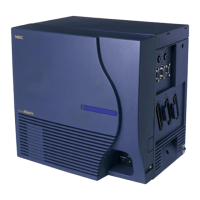Do you have a question about the NEC ITK-8LCX-1 TEL and is the answer not in the manual?
Provides legal information regarding product specifications and copyright.
Describes the structure and contents of the manual.
Provides an overview of the product and its usage.
Details procedures for configuring the terminal's settings and functions.
Explains how to use various features and operations of the telephone.
Contains supplemental information and reference materials for the manual.
Explains the meaning of symbols and marks used in the manual.
Defines key terms and terminology used throughout the manual.
Illustrates and identifies the physical keys and parts of the telephone.
Details the technical specifications and features of the telephone models.
Explains the function and location of each key and part on the terminal.
Describes the functions of the soft keys displayed on the screen.
Provides a general overview of the telephone's functions and operation.
Explains the initial display and setup when the telephone starts.
Describes how to use shortcuts for quick access to frequently used functions.
Details the content displayed in the information area of the screen.
Explains the meaning of various icons displayed on the screen to indicate status.
Describes the display area for the clock and calendar and how to format it.
Explains how to access and use the main call screen for operations.
Details the type of character information indicated from the system.
Describes the system-provided soft keys and how to select them.
Explains the soft keys provided by the terminal and navigation options.
Details the procedure for activating the call screen from different states.
Explains conditions under which the call screen closes automatically.
Describes the screen displaying line key information and its status.
Covers personal and system phonebooks for managing contacts and making calls.
Explains how to view and manage call history records.
Describes how to access the terminal's settings menu for configuration.
Details the steps for installing and attaching components to the terminal.
Instructions for safely removing the faceplate and DESI printer sheet.
Steps for reattaching the faceplate and DESI printer sheet.
Explains how to adjust the terminal's height using tilt legs.
Steps to raise the terminal's tilt legs to the desired height.
Steps to lower the terminal's tilt legs to adjust height.
Instructions for installing an optional directory card for storing information.
Guides on connecting the LAN cable for network connectivity.
Information on available headset types and connection procedures.
Details the process of connecting a headset to the terminal's connector.
Step-by-step guide for physically plugging in the headset.
Explains how to adjust speaker, handset, and ringer volumes.
Guides on enabling or disabling the headset ringer.
Describes how to set the ringer tone for incoming calls.
Explains ringer tone settings for distinguishing call types.
Details ringer tone settings when distinctive patterns are not available.
Explains how to set the illumination pattern for the call indicator lamp.
Guides on enabling or disabling RTP Alarm for network delay notifications.
Explains how to enable or disable DTMF tones during calls.
Details how to set the touch tone generated when keys are pressed.
Explains how to set Music on Hold heard by the terminal user.
Guides on setting a prefix number for calls.
Explains how to set the calendar format for display.
Explains how to set the time format for display.
Determines whether volume levels are displayed on the screen.
Guides on setting up the screen saver for idle terminals.
Explains how to adjust the brightness of the LCD backlight.
Guides on enabling backlight fade control for smooth display changes.
Explains how to change the font size displayed on the LCD.
Describes how to select the language for display on the LCD.
Explains how to set the wallpaper for the Home Screen background.
Guides on setting the character color displayed on the LCD.
Explains how to set the display to turn off automatically when idle.
Explains how to change the screen image and appearance.
Guides on changing the theme color of the terminal's screen.
Explains how to enable or disable screen change animation.
Details settings related to the screen displayed when the phone starts.
Guides on setting the screen displayed upon startup or Home key press.
Explains how to register a URL to access XML applications on startup.
Describes the automatic access to home URL and XML application display.
Explains how to change the existing password for terminal security.
Explains how to set the pop-up operation of the Home key.
Guides on clearing personal data and resetting terminal settings.
Details downloading files for Music on Hold, Ringer Tone, and Wallpaper.
Explains how to back up and restore terminal settings to/from a server.
Details the procedure for backing up terminal settings to a server.
Explains how to restore terminal settings from a server.
Guides on setting up and managing Bluetooth® devices.
Explains how to enable the Bluetooth® function on the terminal.
Details the process of pairing and connecting Bluetooth® devices.
Explains how to check paired devices and disconnect them.
Guides on setting the inquiry time for Bluetooth® devices.
Shows how to display Bluetooth® module information.
Describes the favorite screen displaying registered shortcuts for quick access.
Explains how to select and navigate shortcuts on different terminal models.
Illustrates the icons displayed for each shortcut type.
Describes the names displayed for each shortcut.
Guides on registering new shortcuts for frequently used numbers or services.
Explains how to activate and use registered shortcuts.
Explains how to change the display method for shortcuts on the favorite screen.
Guides on editing existing registered shortcut information.
Explains methods for deleting shortcuts from the favorite screen or user settings.
Details the process of deleting individual shortcuts.
Explains how to delete shortcuts via the user settings menu.
Describes the call screen and system service operations.
Explains how to navigate and select system soft keys on different models.
Shows sample displays of soft keys based on terminal status.
Provides sample operations for using system soft keys for various features.
Guides on setting the Do Not Disturb feature.
Explains how to cancel the Do Not Disturb feature.
Details setting call forwarding when the line is busy.
Explains how to cancel call forwarding for a busy line.
Covers personal and system phonebooks for managing contacts.
Details how to use and manage the personal phonebook on the terminal.
Explains how to search for contacts within the phonebook.
Guides on making calls using phonebook entries.
Details making calls directly from the call history list.
Explains how to make calls with a specific prefix number from history.
Guides on modifying existing entries in the personal phonebook.
Explains how to delete specific records from the phonebook.
Details adding a prefix to telephone numbers in the local phonebook.
Explains how to change the name of a group in the phonebook.
Provides information on inputting telephone numbers and selecting categories.
Explains how to delete contacts from the phonebook.
Describes system-side call history storage and limitations.
Guides on accessing and viewing call history records.
Explains how to initiate calls directly from the call history list.
Details making calls with a prefix from the call history.
Explains registering call history data into the directory.
Guides on adding new entries to the directory.
Details adding call history data to existing directory entries.
Explains deleting call history data.
Provides character input methods for various menus and fields.
Details input methods for terminal passwords.
Explains input methods for user ID, password, folder, file name, and address.
Details input methods for IP addresses.
Describes using multiple XML applications simultaneously.
Explains how to switch between running XML application windows.
Details error handling when starting more than four XML applications.
Explains the meaning of 'NEW' and 'UPDATE' icons for XML services.
Guides on activating the terminal with Login ID and Password.
Explains how to log out from the terminal when in Login Mode.
Describes displaying lines in double height size on the LCD.
Explains how to change the line targeted for double height display.
Guides on making calls to external numbers.
Explains how to make calls to internal extensions.
Guides on answering incoming external calls.
Explains how to answer incoming internal calls.
Allows accommodating multiple lines and handling calls on them.
Guides on initiating calls using multiline features.
Explains how to answer calls on other lines.
Guides on placing calls on hold.
Explains how to retrieve held calls.
Details placing calls on hold, excluding others from retrieving them.
Explains automatic recall initiation for unanswered calls.
Guides on transferring calls to another party.
Explains originating calls using dynamic dial pad and preset dial.
Details using one-touch speed calling keys for quick dialing.
Guides on making calls using one-touch speed dialing.
Explains how to set up one-touch speed calling keys.
Guides on verifying the numbers assigned to speed dialing keys.
Explains speed dialing for station and group contacts.
Guides on setting speed dialing for station/group.
Explains registering names onto one-touch speed dialing keys.
Guides on making calls using speed dialing.
Explains system-wide speed dialing configurations.
Details setting system speed dialing keys.
Explains operating speed dialing via system keys.
Guides on adding, editing, or deleting one-touch speed dialing keys.
Explains adding new data to one-touch speed dialing keys.
Guides on replacing existing data on speed dialing keys.
Explains editing registered data for speed dialing.
Guides on entering phone numbers for speed dialing.
Explains entering hooking information for speed dialing.
Guides on entering pause entries for speed dialing.
Explains entering voice call settings for speed dialing.
Guides on deleting entered characters during speed dialing setup.
Explains deleting phone number data from speed dialing.
Guides on deleting numbers from one-touch speed dialing keys.
Explains switching registered keys for one-touch speed dialing.
Explains the redial feature for making calls.
Details redialing the last dialed number.
Guides on redialing the last number dialed.
Explains deleting individual call records from history.
Guides on deleting all outgoing call history records.
Explains recalling the last dialed number.
Explains making voice calls using feature or soft keys.
Guides on setting up and conducting three-party conference calls.
Details setting up and originating calls via the voice mail system.
Explains setting and canceling the Do Not Disturb feature.
Details the security mode for preventing unauthorized access.
Guides on locking the telephone for security.
Explains how to unlock the telephone using a password.
Explains how to make emergency calls, especially when the phone is locked.
Details user-configurable settings for the terminal.
Explains settings related to incoming calls, ringtones, and illumination.
Details settings related to call operations like RTP Alarm and DTMF tone.
Explains settings for display options like calendar format, time format, and screen saver.
Covers advanced settings including wallpaper, font color, and turn off display.
Details Bluetooth® settings for device pairing and connection.
Explains the process and requirements for downloading files like music and wallpaper.
Details procedures for backing up and restoring terminal data.
Shows character codes for entering names in speed dialing.
Provides character input codes for password entry in menu contents.
Character codes for inputting user ID, password, folder, file name, and address.
Character codes for inputting IP addresses.
| Brand | NEC |
|---|---|
| Model | ITK-8LCX-1 TEL |
| Category | Telephone System |
| Language | English |












